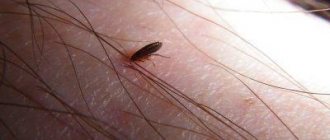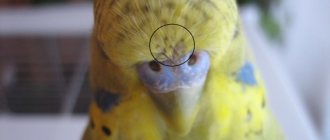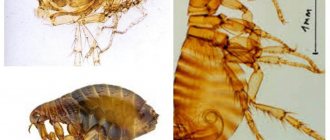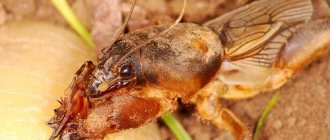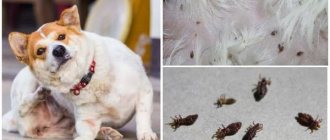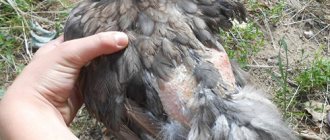Perhaps you will say that my dog cannot have fleas, since you keep your house clean and regularly inspect and wash your dog. But this is not entirely true, and your pet may have hidden “friends” that you had no idea about.
Well, I wonder how and where your dog can pick up such a “gift”?
There are many ways to get a flea.
- Contact with other animals. These could be fleeting interactions while you are walking your pet in the park or in the yard. It could be a cat that got into your yard, or birds, and if you like to walk in the forest, then any wild animals are also carriers of fleas (squirrels, hedgehogs, etc.).
- They can temporarily take refuge in your entrance, basement, on the porch of a house or on a summer cottage, and then, at any opportunity, attack your beloved pet.
- You yourself can become unwitting carriers of this problem and bring them on your luggage when returning from your next trip or business trip.
How can a dog get fleas?
Fleas live anywhere. They live on the street, in houses, apartments, shops, warehouses, and other utility rooms where there may be animals. Moreover, these may not be domestic animals, but rats, which are found everywhere. Rat fleas can also attack dogs.
Most often, a dog picks up fleas while walking on the playground, on the streets, in forests and parks. Infection occurs through contact with other dogs. But also a flea that has fallen from one dog can wait for another victim on the ground, bench, bushes or grass. The contact may not be too close: a flea will easily jump from one dog to another if the distance between them is about half a meter, that is, even when passing nearby.
Owners can also bring fleas home on shoes and outerwear. This is how dogs that do not walk outside and never leave the house become infected with fleas.
Fleas also enter the apartment on their own: through open windows and doors. They penetrate from common areas: basements, attics, corridors, stairs. Many old houses are infested with fleas.
Differences in symptoms from allergies and other parasites
Any parasite, no matter where it has settled, in the skin, on the fur, or inside the animal’s body, causes harm to it. Parasites that can attack your pet and how they compare to fleas:
- Lice. They never leave their habitat. They suck the blood of animals or humans all year round. Just like fleas, they prefer to settle on the withers of the animal, on the stomach or in the folds of the paws. They hide from bright sunlight. Bites bring unpleasant itching and irritation.
- Ticks. These parasites are dangerous in spring and summer. They dig into the animal's skin for a long time. After each walk, you should carefully examine your pet and rid him of this insect in time. An allergic reaction to them does not happen often, but you can easily become infected with a dangerous infection.
- Vlaseaters. These insects are similar to lice. They love warmth and will quickly move to a warm cloth with which you cover the animal to find out about their presence. They differ from fleas in that, like lice, they do not leave their habitat. They have one owner, whose blood they feed on.
- Worms. These are internal parasites, which can be quite difficult to get rid of. Cause severe intoxication of the body. Most dogs suffer from vomiting, diarrhea and intestinal obstruction.
All bloodsuckers have piercing-sucking mouthparts. Every fourth dog has an allergic reaction to their bites.
It is quite easy to recognize a flea from the abundance of parasites that can live on a dog. She is very nimble; if you part the animal's fur to catch an insect, you will not succeed. This is the first and most basic sign that you have a flea in front of you.
Signs of a dog being infected with fleas
It is quite simple to understand that a dog has fleas. The following signs indicate this:
- the dog is constantly itching;
- anxiety, aggression;
- sleep disturbances when the animal suddenly wakes up to scratch itself;
- the appearance of wounds, ulcers, irritations on the skin;
- hair loss, excessive shedding.
Fleas on a dog can be seen by parting the fur and carefully examining the animal. This is not easy to do in thick and dark wool. Most often, parasites can be found on the withers, behind the ears and on the stomach. There can be both adults and eggs and larvae.
Classification
Human . They are brown in color and reach sizes up to three millimeters in length. They differ from other varieties by their excessive jumping ability.
REFERENCE ! They are not constantly present on the human body, mainly only at the time of the bite; at other times, these insects live and breed on pieces of furniture, carpets , etc. Such parasites, as a rule, do not bite animals , preferring only human blood, while animal fleas, on the contrary, will not miss the opportunity to feast on a person.
Felines .
Just like human fleas, they are brown in color, but are much smaller in size. Cat parasites constantly live and reproduce on animals, although they can also bite humans. Suction . They are similar in appearance to other types of fleas; their distinguishing feature is the same habitat. If cat or dog parasites are located throughout the animal’s body, then the suction flea chooses a specific area on the pet’s body, for example, the ears .
Canine . They have a flattened body, three pairs of legs, move freely around the dog, and can jump and bite a person. Such parasites reproduce by larvae, which are deposited in dog fur. Average life expectancy is three years . One adult female flea can lay up to 50 eggs per day, which are almost invisible in the animal’s fur.
Find out about other types of these parasites: earthen, grass, rat, chicken, parrots and hamsters.
Why are dog fleas dangerous?
Firstly, their bites cause severe itching. The dog is constantly itching, anxious, uncomfortable, and in a bad mood.
Secondly, fleas are carriers of pathogens of dangerous infectious diseases: typhus, encephalitis, plague, etc. They carry helminth eggs and other pathogenic microorganisms.
Flea bites also cause severe allergic reactions. After them, irritation appears on the skin and it turns red, hurts, and swells.
Many people think that fleas from dogs are not transmitted to humans. This is true: dog fleas do not live on people. But they bite people. And their bites are unpleasant, causing severe itching and allergic reactions. And if a person is bitten by an infected flea, it can infect him.
How not to get infected?
If your animals are itching non-stop, and you yourself feel an incomprehensible tingling sensation on your legs and arms, which becomes more frequent at night, there is a high probability that fleas have settled in your home.
Finding them is sometimes not so easy. This can be done in the standard way, while combing your pet, or you can conduct a simple test for the presence of fleas.
Place a large white sheet on the floor, turn off the lights in the room and leave the room for one hour. If upon your return you find black “spots” on the canvas that begin to scatter after turning on the light, then it’s time to fight the parasites.
The modern market of veterinary drugs offers a variety of products: sprays, gels, collars, shampoos. Choose one of them after consulting your veterinarian.
As for precautionary measures, do not forget about the following rules:
- Inspect your pet's fur after a walk - parasites can be seen on the scruff of the neck, neck and paws. If fleas are found, immediately bathe him with anti-parasitic shampoo and treat him with a spray.
- Regularly check your pet’s furniture and accessories – bed, rug, plush toys. Wash when dirty and treat with spray.
- If the dog lives on the street, treat the kennel every year at the beginning of spring.
- Before letting your dog outside, put an anti-flea collar on it. Its smell will repel most dangerous parasites. If desired, it can be replaced with special drops on the scruff of the neck.
- Even if only one animal goes outside, all your four-legged household members should be treated for parasites.
Reference! Pine sawdust makes an excellent padding for dog kennel bedding. The specific smell of wood repels parasites from the animal.
Flea remedies for dogs
Manufacturers produce a wide variety of anti-flea products and preparations. They are sold in pet stores and veterinary pharmacies. They have different uses and effectiveness.
Shampoos
Flea shampoos work when dogs don't have too many fleas. Their effect is not very long. There are flea products on sale for dogs based on natural ingredients that only repel parasites. There are also shampoos that contain insecticides that kill insects. You can use insecticides to add to your regular shampoo. For example, Ectometrin from Medilis is added to the dog’s usual bathing product in accordance with the instructions.
It is important to apply the shampoo to the entire body of the animal, but you need to protect the dog’s eyes and mucous membranes from getting it. The dog should not be allowed to lick the foam or drink the shampoo water.
There are special flea shampoos designed for bathing puppies. Each bottle should also indicate whether the product can be used on puppies or pregnant or lactating dogs. Some products are toxic and should not be used on weakened or elderly animals. It is worth consulting with your veterinarian to see if a specific product can be used to kill parasites.
After bathing with shampoo, the dog should be thoroughly rinsed with running water, the coat dried, and then combed to remove dead parasites.
Sprays
This is an effective remedy, but its application is more difficult. You should try to apply the drug not to the fur, but to the skin or as close to it as possible. When processing, you need to protect your respiratory organs and eyes; you must work strictly with gloves. Do not allow the product to get into the dog’s eyes or mucous membranes.
The dog should not be allowed to lick itself for any period of time after treatment. To do this, they put a special high neck collar on her. While the product remains active on the dog’s body, other animals who might lick the drug should not be allowed near it.
Collars
Anti-flea collars are impregnated against fleas and last for several months. After the expiration date, you need to change the collar to a new one. Sometimes collars rub the skin and can cause irritation and dermatitis. They are not recommended for use on puppies or nursing or pregnant dogs as they may be toxic.
Drops
The most effective way to combat fleas is drops on the withers. They are applied in quantities calculated by the weight of the animal. The product spreads throughout the skin and kills fleas quite quickly. The protection lasts for about a month, then the drops are applied again. Also, drops on the withers are used as a preventive measure, even if the animal is not found to have fleas, but it regularly walks in an area where the risk of infection is high.
Powder
The most inexpensive, but quite effective way. The powder is prepared to order at a veterinary pharmacy. It is based on butox. The powder is applied to the animal's skin, spreading the fur. Dogs sometimes become allergic to it, so you need to monitor your pet's condition. The disadvantage of this method, in addition to the inconvenience of application, is that the powder must be used within two weeks.
Folk remedies
All flea medications containing insecticides are toxic. Many owners are afraid to use them, thinking that the pet will be harmed. Because of this, they resort to traditional methods of getting rid of fleas.
What tools can be used:
- bathing in a decoction of wormwood, celandine, tansy;
- bath with tar or laundry soap;
- applying a gruel of crushed garlic or onion to the entire coat or just to the withers;
- adding essential oils of lavender, eucalyptus, mint, and lemongrass to bathing shampoo.
You can also drop a few drops of essential oils onto the litter and place a sprig of dry wormwood. The floors in the room where a flea-infested dog lives should be washed with a solution of salt and soda in equal proportions.
All of the above products, of course, are not as dangerous and toxic as industrially produced insecticides, but they are also ineffective. They are more likely to repel fleas, but not kill them. To get rid of insects, you will have to use such products many times. In addition, they do not destroy eggs. Another problem is that the dog may not like strong-smelling products. She may experience discomfort from them, and her sense of smell may deteriorate.
Prevention
It is quite simple to protect your pet from infection by insects of any kind, if you do not forget to carry out regular preventive treatment of the dog and the room in which it is kept.
Specific actions for prevention:
- Processing with special means . Use flea shampoo regularly when bathing. Once a month, apply drops or spray, or wear a special collar.
- Limiting contact with homeless people and obviously infected animals. Choose places for walking away from possible breeding grounds, which are trash cans and places where dogs constantly gather.
- Weekly wet cleaning of the house and monthly special treatment against parasites . Fleas often only feed on the host; they prefer to live and reproduce in more secluded places. Therefore, treatment with insect repellent compounds is carried out regularly. At home, a solution of vinegar or citrus fruits in water is perfect for this.
- When accepting a gift of another animal's belongings, find out whether the animal has ever been sick. In any case, subject them to heat or special treatment, since flea eggs may not be visible to the naked eye.
Regular high-quality prevention will protect your pet and family from parasites and significantly reduce the risk of contracting many diseases carried by fleas.
How to get rid of fleas on a puppy
Most professional insecticides are not recommended for use on puppies. The fact is that their immune system does not work the same as that of adult animals. It has not yet fully formed, so any outside interference can seriously damage it. Conventional treatment with products that are not specifically intended for puppies can be harmful to health and affect development.
You should also avoid using home remedies, especially those with strong odors, because they can negatively affect your dog’s sense of smell.
To remove fleas from puppies, you need to take only specialized medications from a veterinary pharmacy. The bottle must indicate at what age the product can be used. If you have any doubts about whether a particular drug can be used, it is best to consult your veterinarian.
Photo
In the photo below you can see what the main sign looks like - waste products of fleas in the dog's fur.
Preventing fleas in dogs and puppies
It is impossible to completely protect your dog from fleas. She can pick them up anywhere at any time. But to prevent the infection from becoming too painful, it is important to always carefully monitor your pet’s behavior and carefully examine it. If at least one parasite is detected, you must immediately carry out flea treatment for your pet and your home.
What you need to do:
- treat the dog with drops on the withers, shampoo, powder;
- Be sure to wear a flea collar when walking;
- wash, treat with a steam cleaner, shake out, treat the litter with insecticides. a bed, a house where a dog sleeps;
- carry out general cleaning in the apartment: vacuum, beat, steam or dry-clean carpets, bedspreads, pillows, other textiles, wash floors and all smooth surfaces with insecticides;
- For prevention, after killing fleas, you can periodically wash the floors with water with the addition of essential oils.
To treat premises, you can use insectoacaricidal products produced by Medilis Laboratories: Ziper, Malathion, Neo, Super. They are diluted to the desired concentration and applied by spraying or wiping. One treatment can destroy fleas in the house and prevent their appearance within a month and a half. It is important to use them strictly according to the instructions and take normal safety precautions.
To reduce the likelihood of flea infestation, you should not let your dog interact with stray or unfamiliar animals while walking. It is better to avoid being in places where there are fleas. It is important to keep the dog’s bed or other area clean, clean it regularly, and inspect it for the presence of parasites. Attention to your pet and timely treatment will prevent dangerous diseases and keep the dog’s health and psyche in order.
How to protect your pet
What is important! It is important to prevent fleas from attacking our four-legged friends, so that later we do not have to determine whether there are fleas or not. Therefore, prevention is necessary. This is easy to do with the help of Simparic tablets, which must be given regularly once every 5 weeks. Within 12 hours after giving the tablet, your dog will be protected from 9 types of ixodid (forest) ticks, fleas, ear mites (otodectosis), scabies (sarcoptic mange) and demodicosis. The dog can walk in the rain, swim in a pond or a bath, the effect of the drug is not reduced, and the dog remains under reliable protection! The tablet size is adjusted to the size of your dog. Most dogs eat Simparica themselves. It is convenient to give simparika - at any time convenient for you, regardless of meals.
Simparica was developed specifically for dogs by Zoetis, a world leader in the field of veterinary pharmacology.
